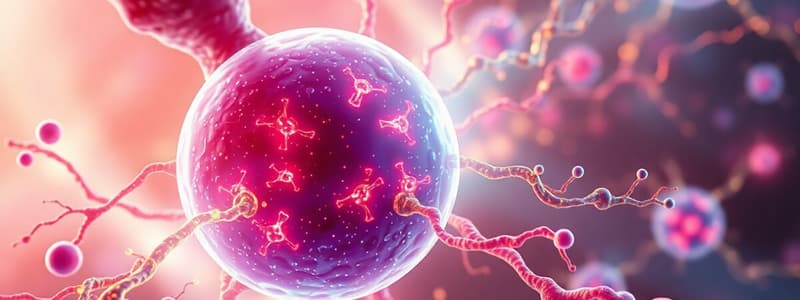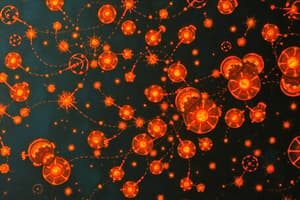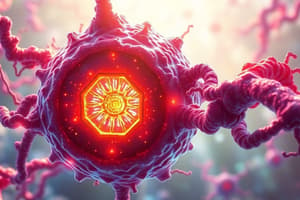Podcast
Questions and Answers
What is the primary focus of cell signaling in the context mentioned?
What is the primary focus of cell signaling in the context mentioned?
Which mechanism is a key part of how neutrophils detect bacteria?
Which mechanism is a key part of how neutrophils detect bacteria?
What is the role of coat proteins in vesicle transport?
What is the role of coat proteins in vesicle transport?
In what context are extracellular signal molecules primarily used?
In what context are extracellular signal molecules primarily used?
Signup and view all the answers
What concept is crucial for understanding how cells convert signals into actions?
What concept is crucial for understanding how cells convert signals into actions?
Signup and view all the answers
What type of signaling involves the shortest range communication between cells?
What type of signaling involves the shortest range communication between cells?
Signup and view all the answers
Which of the following pathways involves the use of networks of neurons?
Which of the following pathways involves the use of networks of neurons?
Signup and view all the answers
What process explains how one type of cellular signal is converted into another?
What process explains how one type of cellular signal is converted into another?
Signup and view all the answers
What is a fundamental characteristic of long-distance signaling in cellular communication?
What is a fundamental characteristic of long-distance signaling in cellular communication?
Signup and view all the answers
Which aspect of cell signaling is primarily associated with the process of signal transduction?
Which aspect of cell signaling is primarily associated with the process of signal transduction?
Signup and view all the answers
In what way do extracellular signal molecules facilitate cell communication?
In what way do extracellular signal molecules facilitate cell communication?
Signup and view all the answers
What process is central to the interaction of neutrophils and bacteria?
What process is central to the interaction of neutrophils and bacteria?
Signup and view all the answers
What role do coat proteins play in the cell signaling process?
What role do coat proteins play in the cell signaling process?
Signup and view all the answers
How is information from extracellular signals primarily translated to induce action in a cell?
How is information from extracellular signals primarily translated to induce action in a cell?
Signup and view all the answers
Which of the following best describes the retrieval pathway in vesicle transport?
Which of the following best describes the retrieval pathway in vesicle transport?
Signup and view all the answers
What kind of communication can be referred to as 'the most intimate' in signaling pathways?
What kind of communication can be referred to as 'the most intimate' in signaling pathways?
Signup and view all the answers
Which concept is important when discussing how cells sense external stimuli?
Which concept is important when discussing how cells sense external stimuli?
Signup and view all the answers
Which statement best describes the relationship between cellular signaling and cell behavior changes?
Which statement best describes the relationship between cellular signaling and cell behavior changes?
Signup and view all the answers
What is the role of extracellular signal molecules in cellular communication?
What is the role of extracellular signal molecules in cellular communication?
Signup and view all the answers
What distinguishes long-distance signaling from local signaling in cells?
What distinguishes long-distance signaling from local signaling in cells?
Signup and view all the answers
In the context of vesicle transport, what is the significance of coat proteins?
In the context of vesicle transport, what is the significance of coat proteins?
Signup and view all the answers
Which of the following best represents the concept of signal transduction?
Which of the following best represents the concept of signal transduction?
Signup and view all the answers
Which characteristic is essential for a signal to be classified as a long-distance signal?
Which characteristic is essential for a signal to be classified as a long-distance signal?
Signup and view all the answers
How do molecular switches play a role in cell signaling pathways?
How do molecular switches play a role in cell signaling pathways?
Signup and view all the answers
What major question does the study of cell signaling attempt to answer regarding cells?
What major question does the study of cell signaling attempt to answer regarding cells?
Signup and view all the answers
Which pathway is primarily associated with the retrieval of receptors in vesicle transport?
Which pathway is primarily associated with the retrieval of receptors in vesicle transport?
Signup and view all the answers
What is primarily responsible for the intimate communication between cells in signaling pathways?
What is primarily responsible for the intimate communication between cells in signaling pathways?
Signup and view all the answers
In terms of signaling, how are long-distance signals typically transmitted?
In terms of signaling, how are long-distance signals typically transmitted?
Signup and view all the answers
Which of the following best characterizes the process of signal transduction?
Which of the following best characterizes the process of signal transduction?
Signup and view all the answers
What is a key advantage of using coat proteins in vesicle transport?
What is a key advantage of using coat proteins in vesicle transport?
Signup and view all the answers
What aspect distinguishes cellular signaling from other forms of communication?
What aspect distinguishes cellular signaling from other forms of communication?
Signup and view all the answers
How does a neutrophil's sensing mechanism influence its behavior reaction?
How does a neutrophil's sensing mechanism influence its behavior reaction?
Signup and view all the answers
Which of the following methods is considered less common for cell communication?
Which of the following methods is considered less common for cell communication?
Signup and view all the answers
What differentiates the secretory pathway from the endocytic pathway?
What differentiates the secretory pathway from the endocytic pathway?
Signup and view all the answers
What role do molecular switches play in cell signaling pathways?
What role do molecular switches play in cell signaling pathways?
Signup and view all the answers
What defines the term 'signal transduction' in cellular signaling?
What defines the term 'signal transduction' in cellular signaling?
Signup and view all the answers
In the context of neuron signaling, what distinguishes long-distance signaling from local signaling?
In the context of neuron signaling, what distinguishes long-distance signaling from local signaling?
Signup and view all the answers
Which of the following best characterizes the coat proteins involved in vesicle transport?
Which of the following best characterizes the coat proteins involved in vesicle transport?
Signup and view all the answers
What role do extracellular signal molecules play in cellular communication?
What role do extracellular signal molecules play in cellular communication?
Signup and view all the answers
What is a fundamental characteristic of the secretory pathway in vesicle transport?
What is a fundamental characteristic of the secretory pathway in vesicle transport?
Signup and view all the answers
What is one of the big questions of cell signaling regarding cell behavior?
What is one of the big questions of cell signaling regarding cell behavior?
Signup and view all the answers
How do cells typically sense external stimuli in the context of signaling pathways?
How do cells typically sense external stimuli in the context of signaling pathways?
Signup and view all the answers
Which aspect of signaling is crucial for neutrophils when responding to bacteria?
Which aspect of signaling is crucial for neutrophils when responding to bacteria?
Signup and view all the answers
Which type of signaling is described as the 'most intimate'?
Which type of signaling is described as the 'most intimate'?
Signup and view all the answers
Study Notes
Cell Signaling Overview
- Cells can communicate with each other through various means, primarily using extracellular signal molecules.
- Signaling can be long distance (via networks of neurons) or local, including short range and even most intimate communication.
- The process by which cells receive and respond to signals is known as signal transduction.
- Signal transduction involves converting one type of signal into another.
Key Concepts in Cell Signaling
- Signal transduction is the process by which a cell converts one type of signal into another.
- Cells use extracellular signal molecules to communicate with each other.
- Communication can be long distance or local.
Neutrophils and Bacteria
- Neutrophils are an example of cells that use signaling to sense and respond to bacteria.
- The key questions about neutrophil signaling are:
- How does the neutrophil sense the bacterium?
- How does sensing the bacterium lead to changes in the cell's behavior?
Receptor-Mediated Endocytosis
- Coat proteins are involved in receptor-mediated endocytosis.
- Different coat proteins are used for different steps in vesicle transport, including the secretory pathway, endocytic pathway, and retrieval pathway.
- There is ongoing debate about the specific roles of coat proteins in these pathways.
Key Questions in Signaling
- How do cells communicate?
- How are signals sensed?
- How is information in a signal translated into action?
Cell Signaling
- Neutrophils sense bacteria
- Sensing the bacteria allows the neutrophil to change its behavior.
- Cells communicate with each other using extracellular signal molecules.
- Cells communicate over long and short distances.
- Long-distance communication can occur through networks of neurons.
- Cells communicate over short distances via direct contact.
- The process of converting a signal into another form is called signal transduction.
Receptor-Mediated Endocytosis
- Different coat proteins are used for different steps in vesicle transport.
- Coat proteins function in recycling receptors to the plasma membrane.
Cell Signaling - An Overview
- Cell signaling is essential for various cellular processes, including cell division, development, growth, and cell death.
- Cells communicate by sending and receiving signals using extracellular signal molecules.
- Signal transduction is the process that converts signals from one form to another to trigger a response.
Receptors and Signal Transduction
- Receptors are proteins that bind to signal molecules and trigger signal transduction.
- Neutrophils sense bacteria through cell signaling pathways.
- The question of how neutrophils sense bacteria and how this sensing leads to changes in neutrophil behavior is answered through understanding cell signaling pathways.
Types of Cell Signaling
- Cell signaling can be divided into long-distance communication and local communication.
- Long-distance communication occurs through the networks of neurons and long-distance signaling molecules.
- Local communication occurs through short-range signals, often by direct cell-to-cell contact.
- The most intimate form of local communication occurs via the short-range signals, like those in the nervous system.
Coat Proteins in Vesicle Transport
- Different coat proteins are involved in different steps of vesicle transport.
- Coat proteins are crucial for the recycling of receptors to the plasma membrane.
- The specific role of coat proteins in the secretory pathway, endocytic pathway, and retrieval pathway is an ongoing area of research.
Cell Signaling 101:
- The study of cell signaling aims to understand how cells receive and respond to signals.
- Cell signaling can be broken down into three main questions:
- How do cells communicate with each other?
- How are signals sensed by the cell?
- How is the information in a signal translated into cellular action?
Cell Signaling
- The lecture discusses cell signaling, a process by which cells communicate with one another.
- Cells use extracellular signal molecules to communicate in various ways, including long-distance communication via networks of neurons and local communication via short-range signals.
- The lecture specifically focuses on cell death signaling pathways and the role of receptor-mediated endocytosis in signal transduction.
- Key questions in cell signaling include: how cells sense signals, how signals are translated into action, and how cells communicate.
Receptor-Mediated Endocytosis
- This process involves the internalization of specific molecules from the extracellular environment.
- Coat proteins play a crucial role in the recycling of receptors to the plasma membrane.
- Different coat proteins facilitate different steps in vesicle transport within the secretory, endocytic, and retrieval pathways.
- The specific coat proteins involved in these pathways remain a subject of ongoing research.
Signal Transduction
- The process by which one type of signal is converted into another is called signal transduction.
- Neutrophils use signal transduction to "sense" bacteria and respond with changes in their behavior.
Cell Signaling
- Cells communicate with each other using extracellular signal molecules.
- Signal transduction is the process of converting signals into an action.
- Some signals are long distance; others are local.
- Long distance signals can be sent through networks of neurons.
- The most intimate signals are short range.
How Cells Sense Bacteria
- Cells like neutrophils need to sense bacteria.
- The mechanism of sensing bacteria is unknown.
- After sensing bacteria, cells need to change their behaviour to adapt.
Questions for Cell Signaling
- How do cells communicate?
- How are signals sensed?
- How is the information in a signal translated into action?
Studying That Suits You
Use AI to generate personalized quizzes and flashcards to suit your learning preferences.
Related Documents
Description
Explore the fascinating world of cell signaling, where cells communicate through extracellular signals. This quiz delves into signal transduction, the role of neutrophils, and how cells respond to their environment. Test your understanding of these essential biological processes.




